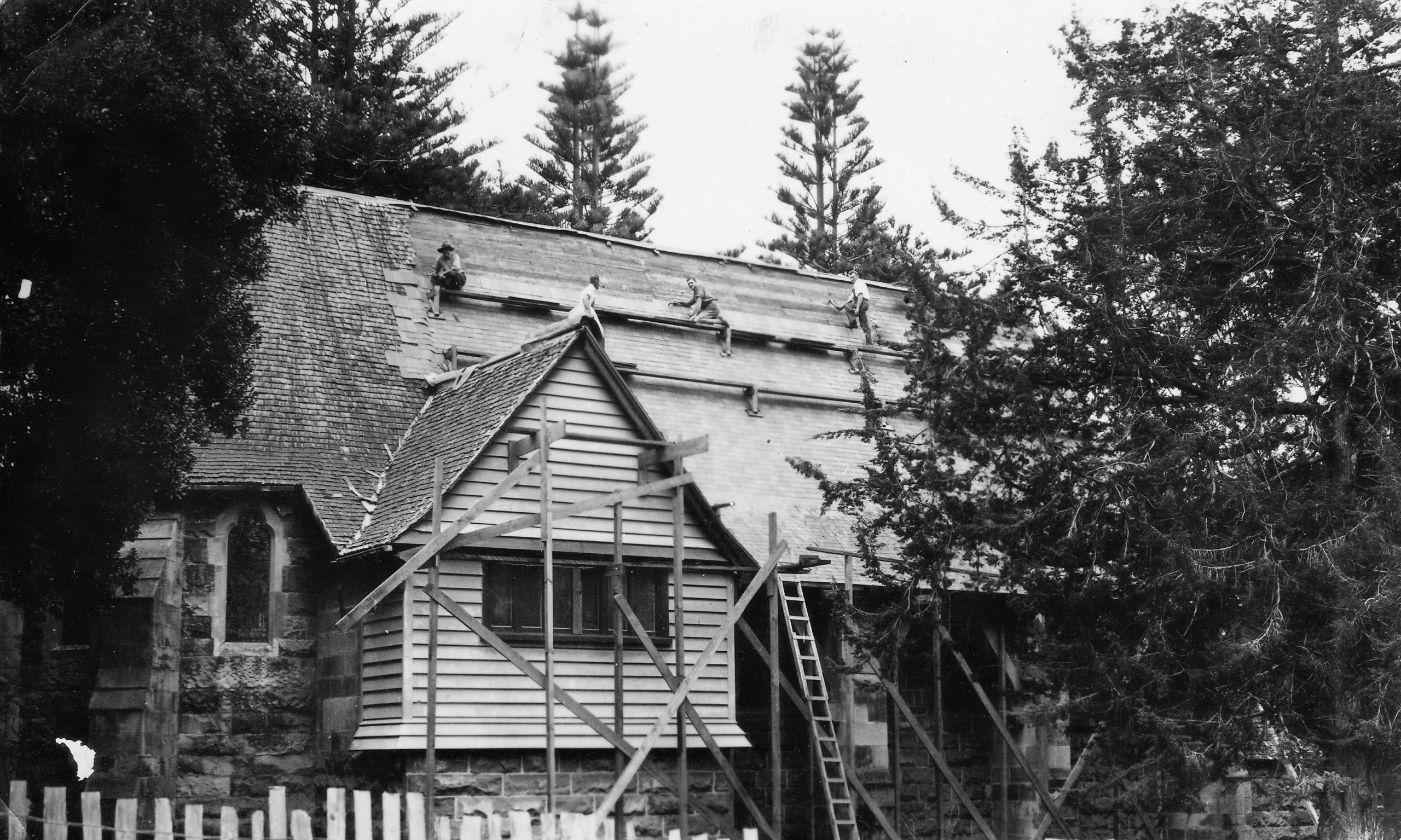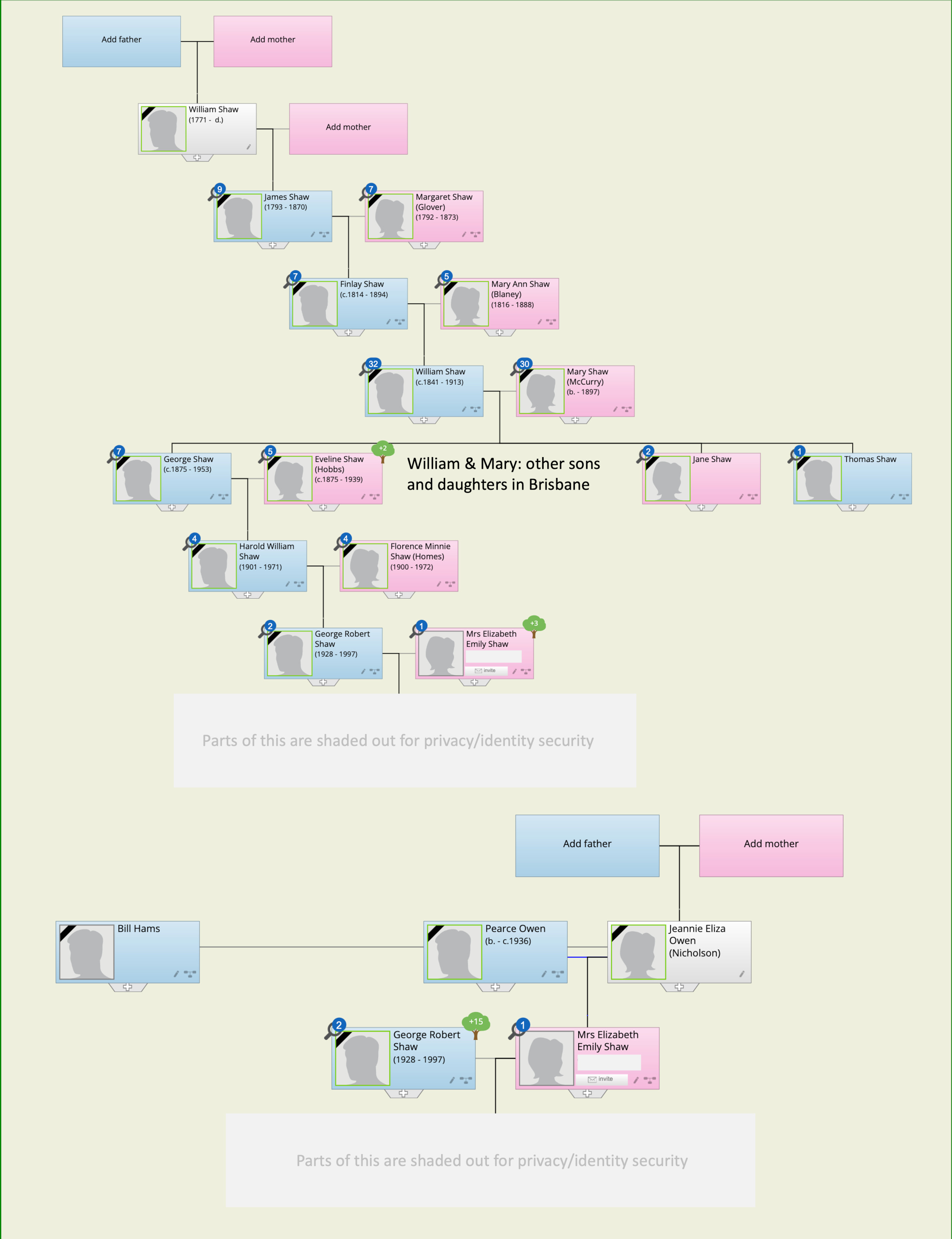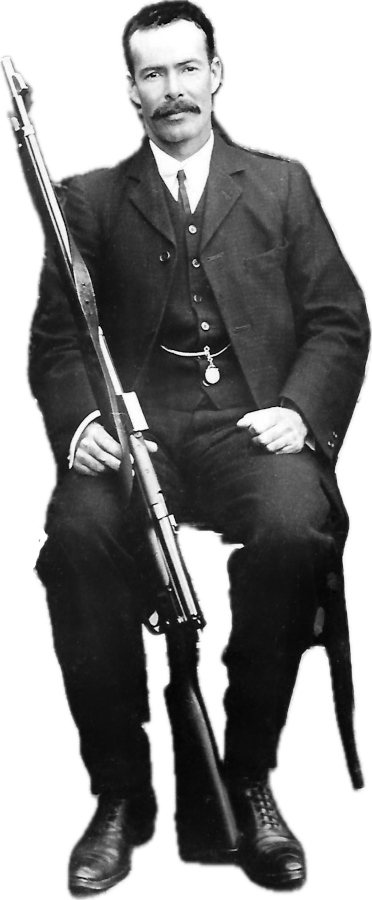St Barnabas Church c. 1930 Norfolk Island – Pearce Owen (right) – Mum’s family
St Barnabas Church c. 1930 Norfolk Island – Pearce Owen (top right) – Mum’s family
Shaw Family Overview
Rifle shooting was a common activity among army members in the early 1900s. The British were surprised to see Australian competitors at Bisley being of equal status. With the threat of War, eventuating in 1914, the rifle competitions were evidence that the Australian army needed to train soldiers in the use of rifles.
George Shaw (snr.) was part of this push to the Federation (1901) by having participated in Colonial competition wins. Prior to Federation competions were self-funded or by donation. By 1902, the Government committed funding and army rifle training. Australian soldiers, it is safe to say, were highly regarded from then on.
The Shaw family was from Northern Ireland, part of the “United Kingdom”. The Irish/English “troubles” and offers from Queensland’s State Government to immigrate may have been why George’s father William Shaw moved to Brisbane with his whole family – further children born in Australia.
The census of 1901 in Northern Ireland showed about 1.4 million people living there, and approx. 3,500 Shaw’s. There were many Shaw’s and limited ancestry digital records available. There are principles of research that include documents, hearsay, objects, photographs, newspaper records, passenger lists, DNA, Church records and so on. Without an evidential basis it is easy to make lineage mistakes. These mistakes underlie assumptions that at first seem right, usually showing problems at a later date that do not add up. My research is documented and supported by multiple sources. We have not had any insight into why George Bernard Shaw had correspondence with the Shaw’s in Brisbane, particularity as GB Shaw was born in Dublin, down the East coast from Northern Ireland. Maybe one day we will know something.
William Shaw (George’s father) set up a retail store at South Bank focusing on ironmongery & hardware (hardware was anything) with his son George as an ironmongery assistant. It is therefore no surprise today that hardware shops sell household appliances like irons and ironing boards. The shop moved to another South Brisbane location and was flooded in the 1893 flood. Shaw had no insurance. He then moved to various locations in the city, eventually beside the now known Commonwealth Bank building in Queen Street, near the post office, in the Granite buildings (demolished). By that stage, the shop was like a mini-Harrods. When Woolworth’s came to Brisbane, they purchased his stock, but did not use the stock, and the business closed on the basis competition would end the business. (I have lost the news article reference.)
Briefly, William Shaw’ son George opened a firearms, fishing, and sports store as firearms and fishing were his love and skills. William did not want him to do this. George’s medals and prize wins supported this direction as being right. Shaw & Sons Limited eventually closed. We have little history apart from newspaper articles via Trove. For instance, one son Henry was involved in ownership. George passed his store to his son Harold, but it was in conjunction with other share holders whose family lines we knew right through the 1970s. Harold had decreasing interest in the store. Harold’s son George Robert Shaw (my father) took over the store and renamed it George Shaw Sports Store. Dad bought out the shares at great cost. Combined with our University educations and interests, none of us wanted to continue Dad’s store.
When Kmart moved to Australia in the 1970’s it also sold firearms and fishing tackle. My father closed his store on the basis of this competition. Years later, Dad said he could have continued the store f he knew what he later learnt. However, Dad’s health was severely impacted from an accident when testing a rifle after having been repaired by his gunsmith workshop. He had minimal education, and no assistance from management consultants. Those days were different. Dad had been expertly trained in detailed knowledge of firearms and light fishing.
In these earlier days, families demanded inheritance rights such as using the same family names, helping the parents when too old, the youngest born being the next inheritor, and passing along the same skills. My mother had a harsh upbringing and poverty. She wanted us to have education. Dad’s shop brought in enough money to do this. My parents had huge financial stresses and challenges. Looking back, we took for granted our new homes and cars, food on the table, education and clothing, but it was not as financial or wealthy as one may think. I believe there was a family ancestral pattern of loss. By the time Dad passed away, Mum had a very modest amount of money based on her building and selling a few homes since her marriage.
The Shaw’s had various connections to the early Congregational and Anglican Churches, public activities and charities. I am grateful for our involvement in the Anglican Church for many reasons. Our private school, Brisbane Boy’s College, preached the Gospel and Resurrection of Jesus Christ. (I need to say these backgrounds still had diverse problems, as did family members from various stories mentioned.)
It has been a considerable journey to find out who George Shaw’s parents were, to confirm by registration records and hand written notes. We have no photos of his father William Shaw. Official records confirm Finlay Shaw was William’ father. There has been speculation this is not the case, but there is no known evidence to say otherwise.
Mum’s side of the family stops with her mother from Northern Ireland and father from Wales. There are so many original records (not digitised) of families that it would be too time consuming and costly to find and research. It was however satisfying for me to see original ink pen records for Mum’s parent’s marriage at the St Barnabas Chapel rectory, and her birth record from a vault in the government building on Norfolk Island.
For personal ID security, details of George Robert and Elizabeth Shaw are not provided on this public page.
Details are available on password protected pages.
The “Harrods” of Brisbane
ChatGPT: Throughout its history, Shaw & Sons played a significant role in Brisbane’s retail landscape, offering a diverse range of products and services to the community.
Keeping things in perspective, there were other retail stores in the 1900’s. Finney Isles & Co is an example.
1915 Photo of Shaw & Sons in Granite Buildings.
Originally three buildings and three stories high. Moved from one building when 4 year lease finished and then occupied by CBA.
Private > Sergeant > Lieutenant (and Quartermaster) George Shaw
Shaw was a Pte (a Private in 1902’s Bisley competition – refer historic nra.org.uk: https://nra.org.uk/wp-content/uploads/k1900-1949.pdf)
Later he was a Sergeant (sgt), and in Bisley’s Mackinnon 1907 competition he was listed as Lieutenant (Lt). Refer: https://nra.org.uk/wp-content/uploads/M1900-1949.pdf. He was also at some point a Quartermaster – supplies.
Shaw was in two matches in 1902, and one in 1907. 1902: Match 12, Match 32. 1907: Match 17.
1875 – 1953 Brisbane, QLD, Australia
Bisley (Kolapore) Cup – Still runs today
The Bisley Cup 1902 was a team competition. It was previously held in Wimbledon, England, and moved to Bisley for a couple of years or so prior to this trophy seen above. It would have been a three-month trip in a ship to get there. It was quite normal in the early 1900’s for men to strap their huge rifles over their shoulders, to be in public on their bicycles to wherever they were going to. Women sports also had rifle competitions.
QRA Governor’s Cup
The Queensland Rifle Association Governor’s Cup, is shown here from 1901. QRA was run by the army. Many from the army were shooters. Being a Sergeant and a champion shooter was a big thing in those days, more popular than cricket and well regarded.
George Shaw & Sons – history
Our Shaw family history goes back to George Shaw senior, son of William Shaw and Mary McCurry, migration from Ireland to Australia. The Firearms & Fishing store in Albert Street in the early1930’s, and Albert street i general, appears to have no digitised photographs on record. The same can be said of many city streets. A few original photos are now with the Brisbane (QLD) State Library archives, June 2022. These can be seen in the “blue” folder called George Shaw Sports Store 1908 – 1979 on this website.
The mounted deer neck is of course sad to see. I don’t know what happened to it. In those days there was hunting as a sport, deer and kangaroo skins as a norm for some people. I never liked these “trophies” or the world of hunting, fishing and firearms from the Shaw’s history.
Website Terms & Copyright
This is my personal website.
Content is protected under Australian copyright laws, all rights reserved.
To use any images please contact me. View Terms
Old Photos
My Photography Background
Developing Amazon AWS Technology Skills

















 Above Top: Harold with my father George, and big fish!
Above Top: Harold with my father George, and big fish!

 Above: views of the laneway in more recent times
Above: views of the laneway in more recent times










